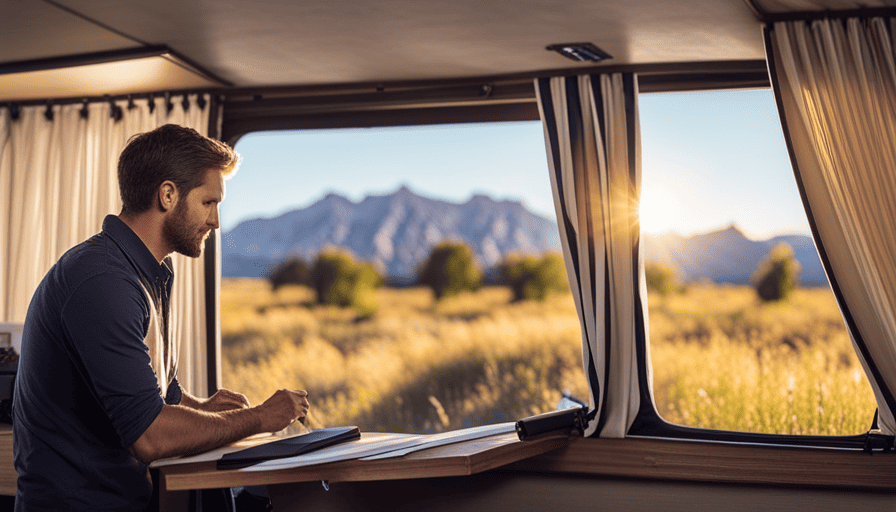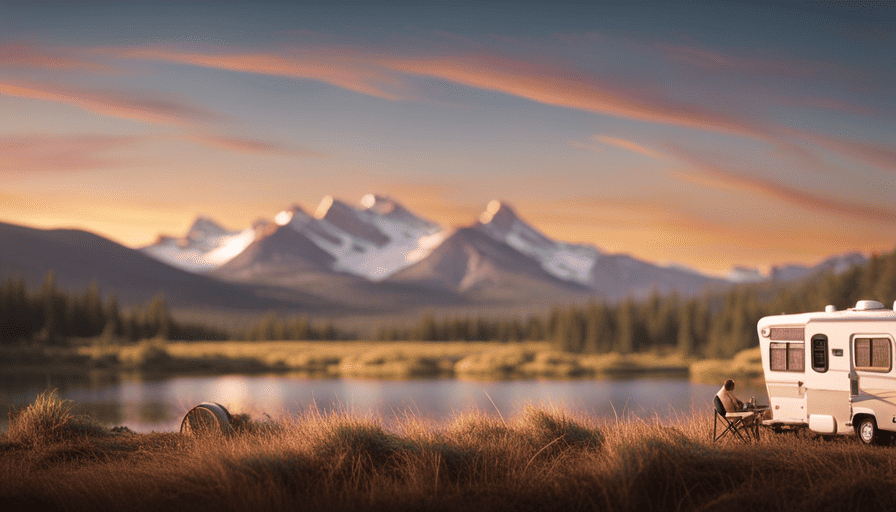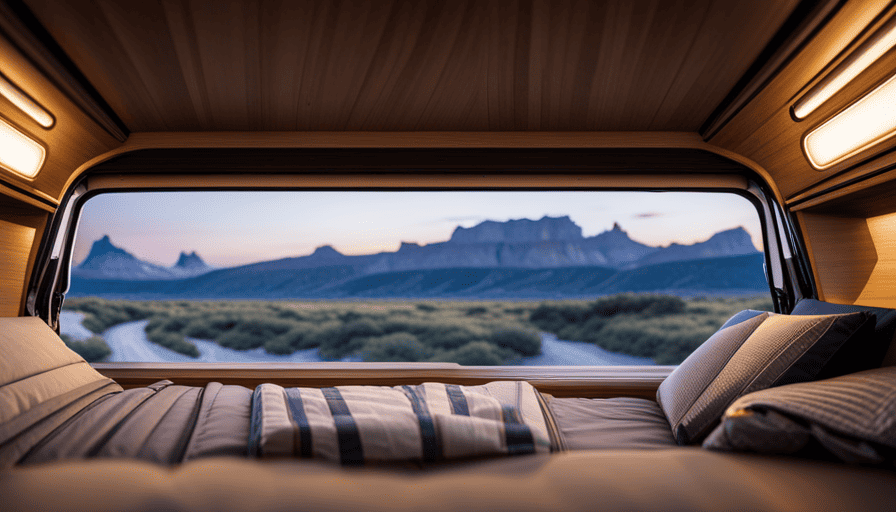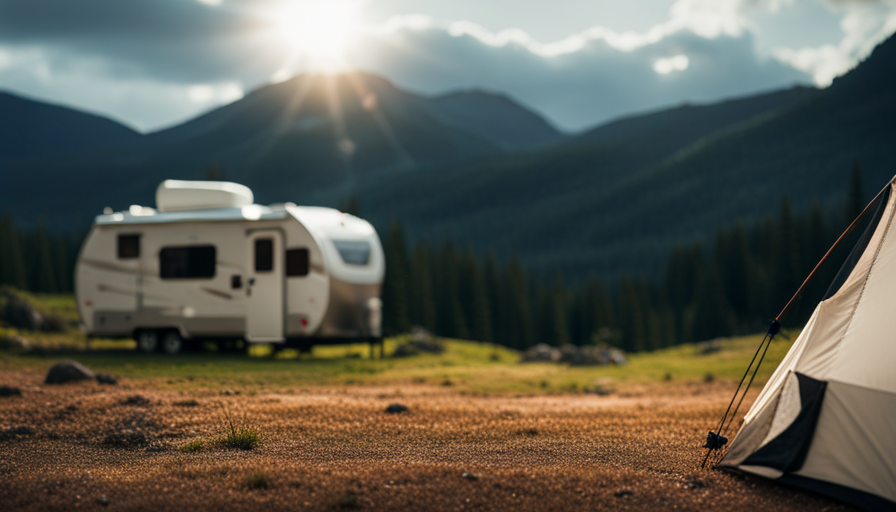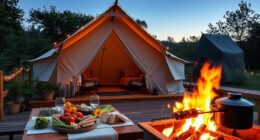As the old adage states, ‘home is where your curtains are hung.’ Thus, when dealing with your pop-up camper, establishing a snug and secluded area is crucial for ensuring a pleasant camping adventure.
But how do you go about hanging curtains in a pop up camper? Well, fear not, because I’ve got you covered with this step-by-step guide.
In this article, I will walk you through the process of:
- Measuring your windows
- Choosing the right curtain rods and hardware
- Selecting the perfect curtains
- Preparing them for hanging
We will then move on to:
- Installing the curtain rods
- Adjusting and securing the curtains
- Testing their functionality
Finally, I’ll share some finishing touches to complete the look and make your pop up camper feel like home.
So let’s dive in and transform your camper into a private and shaded oasis for your next camping adventure.
Key Takeaways
- Measuring windows is the first step to ensure a perfect fit for curtains.
- Choose curtain rods and hardware that complement window measurements and style.
- Opt for lightweight curtain rods and hardware to minimize weight on the camper’s walls.
- Choose durable, lightweight, and easy-to-clean curtain fabrics like polyester blends or cotton twill.
Measure Your Windows
Before you begin, make sure to measure your windows so you can envision the perfect fit for your curtains in your cozy pop-up camper. Proper measurements are crucial in ensuring that your curtains will look great and function properly.
Start by gathering the necessary tools, such as a measuring tape and a notepad to record your measurements. When measuring, be sure to measure both the width and height of each window, as well as any obstructions such as handles or latches that might affect the curtain placement. To get accurate measurements, take the measurements at different points along the window frame, as some frames may not be perfectly square.
Once you have your measurements, you can start considering your window treatment options. Popular options for pop-up camper curtains include curtains with rod pockets or grommets, as well as curtain panels with clip-on rings. These options allow for easy installation and removal, making it convenient for camping trips.
With your measurements in hand, you can now move on to choosing the right curtain rods and hardware to complement your window measurements and style.
Choose the Right Curtain Rods and Hardware
To ensure a secure and stylish installation, you’ll want to select the perfect curtain rods and hardware for your cozy camper space. When it comes to hanging curtains in a pop-up camper, there are a few curtain rod alternatives to consider.
One option is tension rods, which can be easily adjusted to fit different window sizes and require no drilling or permanent installation. Another alternative is magnetic curtain rods, which are great for metal surfaces and provide a sleek and modern look.
Tips for hanging curtains in small spaces include choosing lightweight curtain rods and hardware to minimize the weight on your camper’s walls. Additionally, opt for curtain rods that extend slightly beyond the width of your windows to allow the curtains to hang freely without blocking any light.
When selecting curtain rods and hardware, make sure to consider the overall style and theme of your camper. Choose finishes and materials that complement the interior décor and create a cohesive look.
Now that you have the perfect curtain rods and hardware, it’s time to select the perfect curtains for your camper.
Select the Perfect Curtains for Your Camper
Now that you’ve got your curtain rods and hardware sorted, it’s time to find the perfect curtains to transform your cozy camper into a stylish sanctuary on wheels.
When it comes to selecting the right curtains for your pop-up camper, there are a few factors to consider. First, think about the curtain fabric options available. You’ll want to choose a fabric that’s durable, lightweight, and easy to clean. Polyester blends and cotton twill are popular choices because they’re resistant to wrinkles and can withstand the wear and tear of camping adventures.
Next, consider the curtain color choices. While it may be tempting to go for bold and vibrant colors, it’s important to keep in mind that the limited space of a pop-up camper can quickly feel overwhelming with too many bright hues. Opting for neutral colors such as beige, gray, or even white can help create a calming and spacious atmosphere. Additionally, lighter colors tend to reflect sunlight, helping to keep the interior cooler during hot summer days.
Now that you have an idea of the curtain fabric options and color choices, it’s time to prepare the curtains for hanging.
Prepare the Curtains for Hanging
Once you’ve selected the perfect curtains, it’s time to get them ready to be hung in your camper. The first step is to choose the right curtain fabric. Look for lightweight fabrics that are easy to clean and won’t take up too much space. You’ll also want to consider the color and pattern of the fabric to match your camper’s interior decor.
Next, you’ll need to find alternative hanging methods if your camper doesn’t have built-in curtain rods. One option is to use tension rods, which can be easily adjusted to fit the width of your camper’s windows. Another option is to use adhesive hooks or clips to hang the curtains directly on the walls or ceiling of your camper. Just make sure to choose hooks or clips that are strong enough to support the weight of the curtains.
Once you’ve prepared the curtains for hanging, it’s time to install the curtain rods. This will be covered in the next section.
Install the Curtain Rods
Installing the curtain rods in your camper is like putting the finishing touch on a beautiful painting, bringing everything together in harmony. When it comes to choosing the curtain rod materials, you have two options: wood or metal. Wood rods offer a more rustic and cozy feel, while metal rods provide a sleek and modern look. Consider the overall style of your camper when making this decision.
Now, let’s talk about alternative curtain hanging methods. Tension rods are a popular choice as they are easy to install and require no drilling or hardware. Simply twist the rod to adjust its length and place it between the walls or cabinets. On the other hand, adhesive hooks are a great option if you want to minimize any damage to your camper’s interior. These hooks can be attached to the walls or cabinets, providing a secure hold for your curtains.
Incorporating a 2 column and 3 row table, here is a quick comparison of curtain rod materials and alternative hanging methods:
| Curtain Rod Materials | Alternative Hanging Methods |
|---|---|
| Wood | Tension Rods |
| Metal | Adhesive Hooks |
With the curtain rods installed, we can now move on to the next step: hanging the curtains on the rods.
Hang the Curtains on the Rods
To complete the finishing touch on your camper’s interior, simply slide your chosen curtains onto the rods, allowing them to effortlessly drape and add a touch of personal style to the space.
When hanging curtains on the rods, it’s important to use proper curtain hanging techniques to ensure they stay securely in place while you’re on the road. Start by making sure the curtains are the correct size for your camper windows. Measure the width and length of each window and choose curtains that are slightly longer and wider to ensure full coverage.
Before hanging the curtains, double-check that the curtain rods are securely installed. Use curtain rod installation tips such as using a level to ensure they’re straight and secure. Once the rods are in place, slide the curtains onto them. Make sure they’re evenly distributed and hang straight. Adjust the curtains as necessary to achieve the desired look.
Now that your curtains are hanging beautifully, it’s time to move on to the next step of adjusting and securing them. By following these simple steps, you’ll be able to enjoy the privacy and style that curtains bring to your pop-up camper.
Adjust and Secure the Curtains
Now that you’ve hung your beautiful window coverings, it’s time to make sure they’re perfectly adjusted and securely in place, allowing you to create a cozy and inviting atmosphere in your camper.
Here are some curtain hanging techniques for different types of campers:
-
For pop up campers with curtain rods, adjust the curtains by sliding them along the rod until they’re at the desired height and width. Make sure they cover the entire window to provide privacy and block out sunlight. Secure them by tightening the screws on the rod brackets to hold the curtains in place.
-
If your pop up camper doesn’t have curtain rods, you can use alternative methods to secure the curtains. One option is to use tension rods that can be placed inside the window frame. Simply adjust the tension rod to fit snugly between the walls of the camper, and then hang the curtains on the rod. Another option is to use adhesive hooks or clips to attach the curtains to the walls or ceiling of the camper.
Now that your curtains are adjusted and securely in place, you can move on to the next step of testing them for proper functionality.
Test the Curtains for Proper Functionality
After ensuring the curtains are adjusted and securely in place, it’s imperative to test their functionality to ensure they operate smoothly and effectively.
Testing the curtains for durability is essential to ensure they can withstand the rigors of traveling in a pop-up camper. Start by opening and closing the curtains multiple times to check if they glide effortlessly along the curtain rod. If you notice any resistance or difficulty in movement, troubleshoot by examining the curtain rings and hooks for any obstructions or misalignments. Adjust them accordingly to ensure the curtains move freely.
Next, test the curtains for their ability to block out light. Stand inside the camper and observe if any gaps or spaces allow unwanted light to enter. If you notice any, adjust the curtains or add additional fabric to ensure complete privacy and darkness when desired.
Check the curtains for any sagging or unevenness. Ensure they hang straight and parallel to the camper’s walls. If you spot any sagging, tighten the curtain rods or adjust the hooks to maintain a neat and uniform appearance.
Having tested the curtains for durability and functionality, it’s time to add the finishing touches to your curtains by incorporating decorative elements.
Add Finishing Touches to Your Curtains
The final touch is to infuse your curtains with decorative elements that symbolize your personal style and enhance the overall aesthetic of your camper. When it comes to curtain color options, you have a wide range to choose from. Whether you prefer bright and bold colors or soft and neutral tones, selecting the right curtain color can make a big impact on the ambiance of your pop up camper.
To add a touch of elegance and functionality to your curtains, consider creating DIY curtain tiebacks. This simple project allows you to customize your tiebacks to match your curtains and add a personal touch. You can use materials such as ribbons, ropes, or even repurpose vintage brooches to create unique and stylish tiebacks.
To help you visualize the different curtain color options and DIY curtain tiebacks, take a look at the table below:
| Curtain Color Options | DIY Curtain Tiebacks |
|---|---|
| Neutral Tones | Rope Tiebacks |
| Vibrant Colors | Ribbon Tiebacks |
| Pastel Shades | Vintage Brooches |
| Earthy Tones | Fabric Tiebacks |
By adding these finishing touches to your curtains, you can create a cozy and personalized space in your pop up camper. Enjoy your private and shaded retreat, where you can relax and unwind after a day of outdoor adventures.
Enjoy Your Private and Shaded Space in Your Pop Up Camper
Indulge in the solitude of your own private and shaded sanctuary within the confines of your cozy mobile abode. Creating a cozy atmosphere in your pop up camper is essential for a comfortable and enjoyable camping experience.
One way to achieve this is by hanging curtains that not only provide privacy but also add a touch of warmth and style to your space. When choosing the right fabric for your curtains, consider the overall theme and color scheme of your camper. Opt for materials that are durable and easy to clean, as they’ll be exposed to the elements and potential spills. Fabrics like cotton, polyester, or a blend of the two are great options. They’re lightweight, breathable, and come in a variety of patterns and colors to suit your personal taste.
To hang the curtains, you can use tension rods or curtain tracks that attach to the ceiling or walls of your camper. Measure the dimensions of your windows and cut the fabric accordingly, leaving a few extra inches for hems. Sew the hems using a sewing machine or fabric adhesive for a neat finish.
By following these steps and choosing the right fabric, you can create a cozy and inviting atmosphere in your pop up camper, turning it into your very own private oasis on the road.
Frequently Asked Questions
How do I clean my curtains in a pop up camper?
So, you’ve found yourself in the delightful predicament of needing to clean your curtains in your pop-up camper. Fear not, my friend, for I’m here to guide you through this harrowing task.
To rid your curtains of stains and grime, start by removing them from the camper. Gently hand wash them using a mild detergent and cold water. For stubborn stains, a little pre-treating with a stain remover should do the trick. Finally, hang them to dry and voila! Good as new curtains for your cozy camper.
Can I use regular curtain rods and hardware in a pop up camper?
Yes, you can use regular curtain rods and hardware in a pop-up camper. However, there are curtain rod alternatives and ways to hang curtains without hardware that may be more suitable for a camper. For example, you can use tension rods or adhesive hooks to hang curtains without drilling holes. This allows for easy installation and removal, while still providing a secure and functional way to hang your curtains in a pop-up camper.
How do I prevent my curtains from sliding on the rod while driving?
To prevent my curtains from sliding on the rod while driving, I use curtain clips or rings with clips. These can be easily attached to the top of the curtains and then clipped onto the curtain rod.
Additionally, I make sure to secure the curtains tightly by adjusting the tension on the rod or using Velcro strips to hold them in place. These methods have proven effective in keeping my curtains secure during travel.
What type of curtains are best for insulating the camper?
Did you know that the right curtains can make a huge difference in insulating your camper?
When it comes to choosing the best curtain materials, there are a few options to consider. Thermal curtains are a popular choice as they’re designed to keep the heat in during winter and block out the sun’s rays in summer. Another option is blackout curtains, which not only provide insulation but also block out light. However, keep in mind that thicker curtains may take up more space and add weight to your camper.
How do I hang curtains in a pop up camper with limited wall space?
To hang curtains in a pop-up camper with limited wall space, there are alternative methods you can try. One option is using tension rods that can be placed between cabinets or other sturdy structures.
Another method is using adhesive hooks or Velcro to attach the curtains directly to the ceiling or window frames.
You could also consider using magnetic curtain rods that can be attached to metal surfaces.
These methods allow you to hang curtains without relying on traditional wall space.
Are the Methods for Hanging Curtains in a Pop Up Camper Different from a Regular Camper?
When it comes to hanging curtains in a camper, the methods may differ between a regular camper and a pop-up camper. The main difference lies in the construction of the camper and the type of curtain hardware used. It is important to consider the structural limitations and choose appropriate hanging solutions for each camper type.
Conclusion
In conclusion, hanging curtains in a pop-up camper is a simple and practical way to add privacy and shade to your space. By following the steps outlined in this article, you can easily measure your windows, choose the right curtain rods and hardware, select the perfect curtains, and install them securely.
For example, Sarah, a camper enthusiast, followed these steps and hung beautiful floral curtains in her pop-up camper, instantly transforming it into a cozy and private retreat. Now she can enjoy camping with added comfort and style.
So go ahead and give it a try, and create your own personalized oasis in your pop-up camper. Happy camping!

